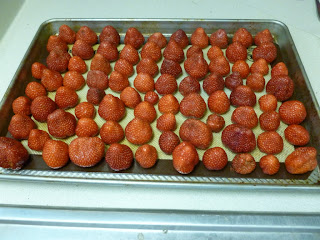We've talked about our garden quite a bit on these pages, but there is still one garden we haven't made much mention of, and it's nearly as important as the main one: our herb garden. If you've ever bought fresh herbs at the grocery store, you can probably see how a few seed packets or started plants can save you lots of money in the long run. Every time we opened one of those $2-3 plastic packages of basil or cilantro, we've vowed that our new garden would have a dedicated space for herbs. And now we have one!
We planted ours in one of our now-standard raised beds, but kept this one to 4x4 square as opposed to our usual 4x8 shape. In this space, we have some of virtually all the herbs we most frequently use in our cooking. Chives, cilantro, oregano, parsley, sage, basil, and rosemary, plus a new one for us - Thai holy basil. Many of these we grew from seeds, but some of the others were slow to germinate so we bought started plants.
Rosemary in particular is a good one to buy at a garden store. Unlike most other herbs, rosemary is actually a perrenial, meaning it can come back year after year. In our climate the winters are too harsh to allow this, so you either have to start over each year, or bring the plant inside in a container until it warms up again. Which brings up another great point about herbs - they are fantastic for container gardening! You don't need to have a big garden like we have to grow these plants; a planter placed on a sunny balcony can do just as well. This makes herbs a fun way to ease into trying to grow some of your own edibles.
As you can see in these pictures, Stacia had some fun labeling our herbs. All it took was a few nice flat rocks, some white paint, and spray-on laquer to seal the surface. Working in the construction industry, Stacia sees a lot of rocks, so it was easy for her to scoop up a few interesting-looking ones for a little craft project. Not that we need much help identifying that giant bunch of lovely aromatic basil, but it just makes things look pretty. And functional though our garden may be, we still want it to look nice.
And, the herb garden is just as great in practice as it is in theory. The other night, we made some quick spaghetti with a homemade sauce. We did the sauce "stone soup" style, simply throwing in a little of every vegetable we had that we thought sounded good. As it simmered, we were able to step outside to the herb garden and snip a few herbs that we thought would go well with it.
We harvested a few sprigs of oregano and a good-sized bunch of basil, then chopped them up finely and added them to our simmering sauce. Immediately you could smell the difference, and soon the distinctly Italian aroma of these two herbs wound its way through the house. We had planned to let this sauce simmer for at least 40 minutes, but before long it smelled just too good to wait any longer and we had to eat.
Nothing particularly novel here - just a bowl of spaghetti noodles topped with a tomato and vegetable sauce, but the ability to add our own fresh-picked herbs really made things noticeably tastier. If you've got a garden, you just have to grow your own herbs. If you don't have a garden yet, herbs are a great place to start!
























